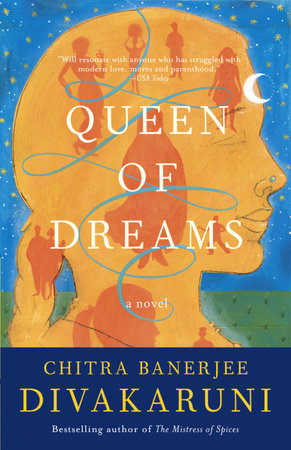Queen of Dreams Reader’s Guide
By Chitra Banerjee Divakaruni


1. Compare Rakhi’s parenting style to that of her mother. To what do you attribute these differences? What universal wisdom about mothers and daughters does the novel convey?
2. What is the significance of the snake and its presence in the life of Rakhi’s mother? Does it provide enlightenment, or is it merely a messenger? Is it an ominous or wise presence in her life?
3. What transformations occur in Rakhi after her mother’s death? How do her attitudes toward Sonny and her father change? What obstacles prevented her from trusting them previously?
4. How do you perceive Jona’s visionary gifts? As a twenty-first-century Californian, will she benefit more from her dream-telling gifts than her grandmother, or will her intuitive legacy be diminished by contemporary Western culture?
5. Chapter 21 describes the process by which Mrs. Gupta was trained in her arts and the many sacrifices (emotional as well as material) presented by life as a dream-teller. What insight does her experience offer about the nature of all vocational choices? Does the modern world encourage us to discern and nurture our true talents?
6. Chitra Banerjee Divakaruni presents a variety of points of view in Queen of Dreams. How does Rakhi’s storytelling voice compare to the one presented in her mother’s journals? What is the effect of the occasional chapters narrated in third person?
7. What does it mean to be a “queen of dreams”? What are the duties and powers of this position? Who are her subjects? How would you characterize her kingdom?
8. Consider the lessons presented in chapter 11. What results do you derive from applying them to your own dreams? What is your personal understanding of the purpose and origin of dreams, especially in response to the portions of Samyukta’s speech recalled in the closing paragraphs of chapter 27? How do the various otherworldly images presented in the novel illustrate the essence of the primary characters?
9. How did your perception of Rakhi change throughout the book? Did you initially see her as a pessimist or a realist, or neither?
10. In what way do Jespal and Belle serve as a backdrop for the paradoxes of love and companionship presented elsewhere in the novel?
11. How do you interpret the story of Nehar the Unfortunate? Do the lesson questions presented at the end of chapter 18 parallel your approach to literature? What would they teach a dream-teller?
12. Discuss the novel’s portrayal of 9/11 and the impact of terrorism on Rakhi’s community. What microcosm of America is embodied in Kurma House International? What safe havens or coping strategies did you seek during the autumn of 2001?
13. What is your understanding of the mysterious black car and Rakhi’s silent patron? What is the significance of her asana lesson?
14. Rakhi’s childhood memories of her father indicate the true depth of his unrealized talent, at last brought to life when he joins her business. What was the impetus for his decision to cook once again, despite his pragmatic persona? What do you make of his desire to establish an honor system for payment and his belief that gratitude does not need to be articulated? Do you believe that on some level he was able to “banish” Rakhi’s ominous competitor?
15. Consider the second definition of dreams–those related not to sleep, but to aspiration. What hopes and wishes are presented in Queen of Dreams? What ultimately determines whether those dreams come to fruition?
16. How does the meaning of the first chapter change, when explored in the context of the novel’s ending? How does Mrs. Gupta approach her own death? Would you be able to receive such predictions as calmly? What enabled Rakhi to experience bliss at last, even in the wake of tragedy?
17. Are the premonitions in the novel beneficial for the characters? Do the premonitions help or hurt their situations? Do you believe premonitions can be real?
Just for joining you’ll get personalized recommendations on your dashboard daily and features only for members.
Find Out More Join Now Sign In